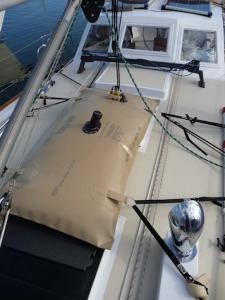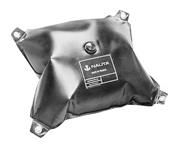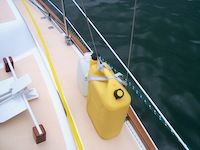Among my humongous list of things to do is to figure out how to carry more diesel fuel. The Tartan 41 was always intended to race, so only had a 27 gallon tank. On Alchemy, the previous owner had replaced that with a 40 gallon tank. With a 1,500 mile crossing to get to the Caribbean, I suspect that might not cut it.
It’s pretty easy to figure out your range, you just need to use speed, distance and time. A good estimate for speed is 5 knots. That is how far in miles you can go in one hour. A good estimate for fuel efficiency is 1 gallon per hour.
So, most boats could go 5 miles on one gallon. A 40 gallon tank would have a range of 200 miles.
Most passage sailors strap a few of those yellow plastic diesel fuel cans on the rails. The common problem with this is that it’s a pretty good way to get them ripped off by a wave and lose your lifelines in the process.
Taking a look at recent entries in the Carib 1500, several captains have used a mil-spec flexible fuel bladder. For example Bob Woods in 2011 used a 50 gallon version (quoted from Sail Magazine):
 The fuel bladder worked well. It never shifted, leaked, or caused concern. We decided to empty it as soon as the main fuel tank would hold the 48 gallons we had filled it with. We found we had to stand on the bladder to get the fuel flowing. This worked well and the fuel was transferred with no spillage or other difficulties. The empty bladder was left strapped to the deck for the remainder of the trip. When we prepared the boat to be left in Nanny Cay, we stored it below the front berth.
The fuel bladder worked well. It never shifted, leaked, or caused concern. We decided to empty it as soon as the main fuel tank would hold the 48 gallons we had filled it with. We found we had to stand on the bladder to get the fuel flowing. This worked well and the fuel was transferred with no spillage or other difficulties. The empty bladder was left strapped to the deck for the remainder of the trip. When we prepared the boat to be left in Nanny Cay, we stored it below the front berth.
 There are relatively few manufacturers of fuel bladder tanks. In my research, Imtra’ Nauta Flexible Tanks seemed like a high quality product.
There are relatively few manufacturers of fuel bladder tanks. In my research, Imtra’ Nauta Flexible Tanks seemed like a high quality product. I am currently seeing if I can get one for our needs. Imtra have been generous enough to help provide a 25 gallon flexible tank.
Update Feb 1, 2014
I actually contacted Mia at the Caribbean 1500 and asked about fuel use. She said:
“Fuel consumptions is always tough to say because it depends on your preference. To give you an idea from last year, the least a boat motored for propulsion was 6 hr, 20 min, and the one with most engine hours (propulsion) was 116 hr. Some people like to turn the motor on if the wind drops slightly, others like to sail in lighter winds. Also, one other aspect to consider is how you will be charging your batteries, do you have solar, wind or other way to charge your batteries, or will you rely on your engine or generator to charge batteries?”


2 thoughts on “Using A Fuel Bladder to Extend Range”
Comments are closed.